Visiting the Alhambra in Granada is a very special experience.
Throughout this Moorish palace complex, the simplest materials – brick, wood, plaster and clay – are transformed into sensual pieces of architecture. The use of space, light, water and decoration is magical.
In short, this is one of the most beautiful palaces in Europe. I love it so much that I have visited La Alhambra three times.
Discover the best way to visit this UNESCO-listed site with my essential tips for visiting the Alhambra Palace. From buying tickets to the best things to see, I’ve got you covered.
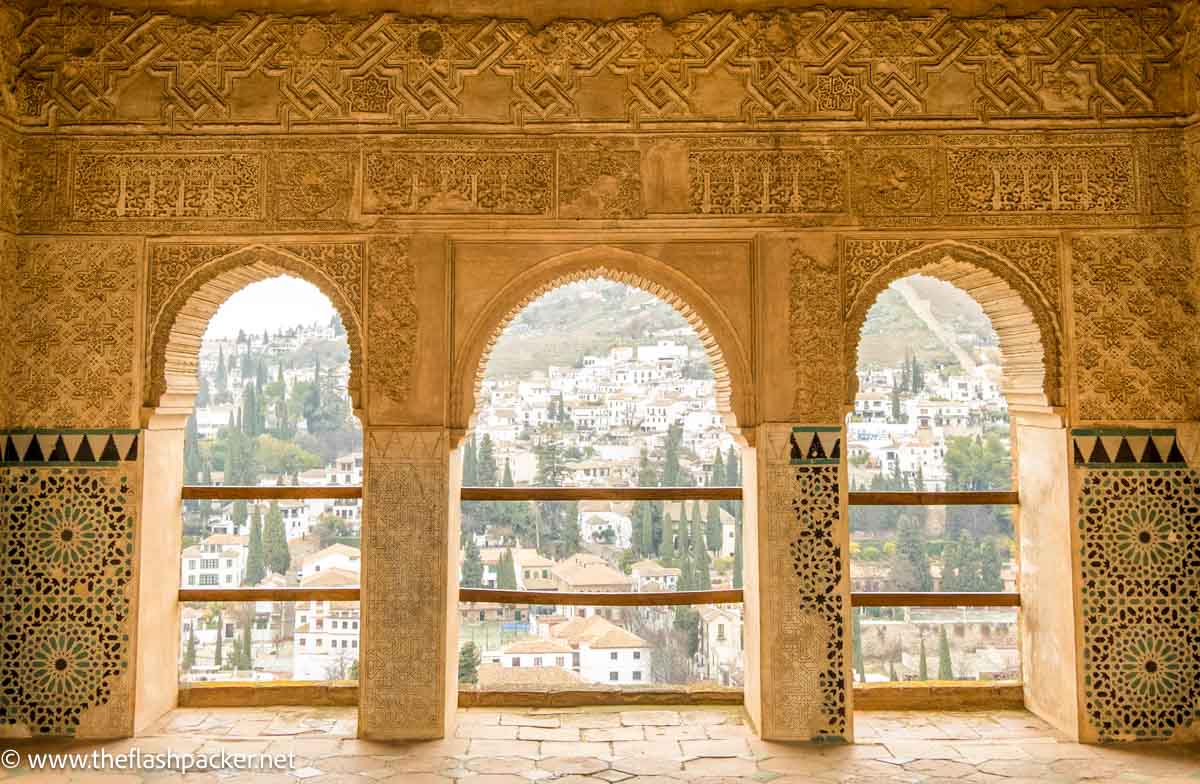
Some articles on this website contain affiliate links. This means that I may earn a small commission if you make a purchase through these links. As an Amazon Associate, I earn from qualifying purchases. Read the full disclosure here.
My Best Alhambra Tips
Nothing can prepare you for the grandeur of the Alhambra. From the courtyards and gardens with their softly tinkling fountains to the delicate stone tracery of its architecture, few places on the planet are its equal.
Ready to discover the best way to see the Alhambra? Based on my three visits, this comprehensive guide includes essential tips, information on the palace complex, how to plan your visit, how to buy Alhambra tickets and much more.
1. Learn a little about the history of La Alhambra before your visit
Just a little. Trust me; it will enhance your Alhambra visit no end.
Construction of the Alhambra began in 1238 by Ibn el-Ahmar, the first king of the Nasrids, and continued under Yusuf I (1334–54) and his son Mohammed V (1354-91). After the reconquest, Ferdinand and Isabel made the Alhambra their home for a while.
Whilst they left the palace largely unscathed, the same can’t be said for their grandson. Emperor Carlos V demolished an entire wing to build a grandiose Renaissance palace.
By the 17th Century, ruin and decay had set in. Bar a few homeless people and stray dogs, the Alhambra was all but abandoned.
In 1812, it was commandeered by Napoleon’s troops. They tried their best to blow up the complex but were thwarted by a crippled soldier who removed the fuses.
The Alhambra’s fortunes turned with the arrival of Washington Irving in 1829. He set up his study in the empty palace and began to write his impossibly romantic Tales of the Alhambra.
Thirty years after his arrival, restoration of the Alhambra began.
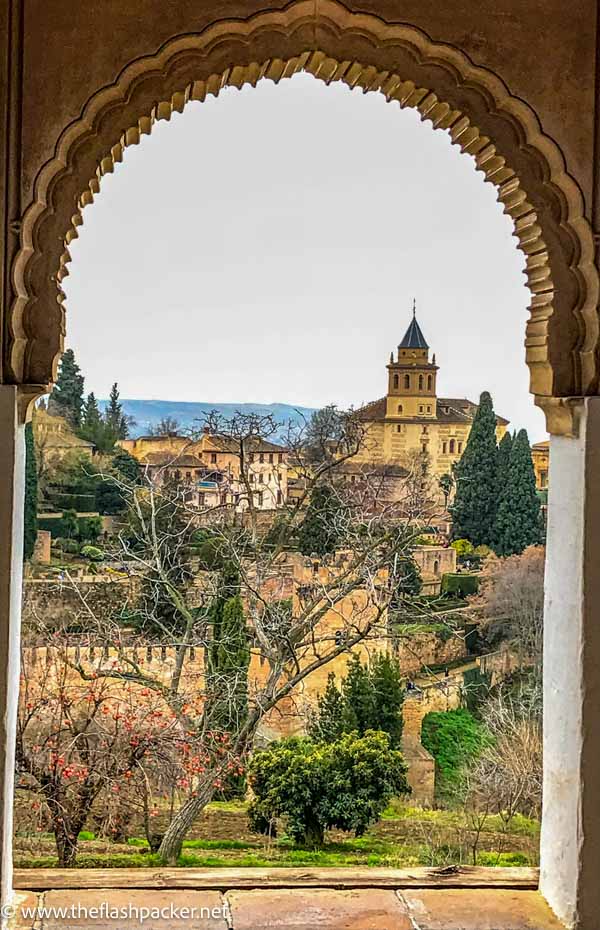
2. Don’t underestimate its scale
The Alhambra is not one singular building but a vast palace complex. The main components are the Nasrid Palaces, the Generalife and the Alcazaba.
- Nasrid Palaces. Also called the Palacios Nazaries or Casa Real (Royal Palace), this is the highlight of visiting the Alhambra.
- Generalife. Gardens and summer palace of the Nasrid kings.
- Alcazaba. The original fortress of the Alhambra.
But that’s not all. Other parts of the complex worth visiting include the Royal Baths (Baños Reales), the Renaissance Palace of Carlos V (Palacio de Carlo V) and the Museum of the Alhambra.
Excluding the walk to and from the Alhambra, I clocked up 5km walking around the complex. Download the official map to get the lay of the land.
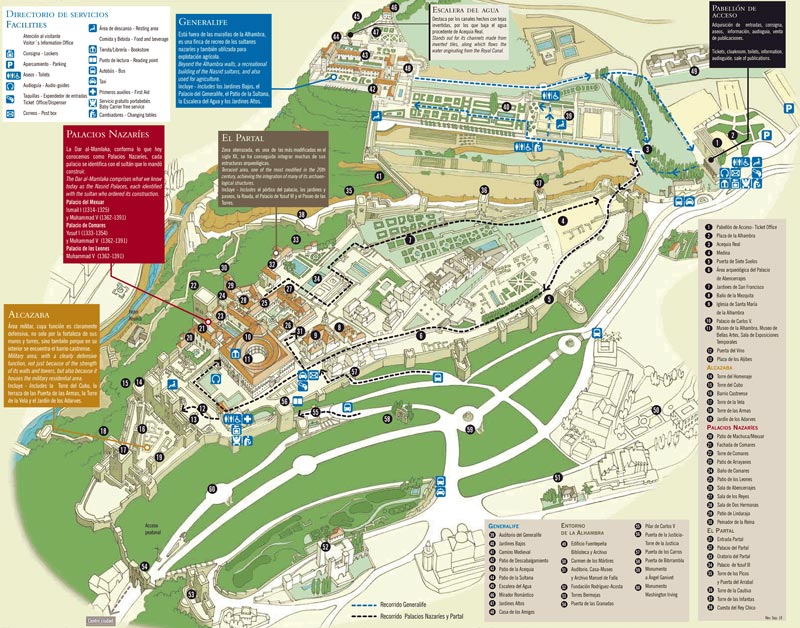
3. Wear appropriate clothing and footwear
This brings me to my third Alhambra visit tip. Leave the stilettos at home. The distance on the pedometer notwithstanding, you will be negotiating cobblestones and shiny marble paths.
If you are visiting the Alhambra in the morning or evening during the winter months, bring layers. I visited Granada in February and although the afternoons were pleasantly warm, it was chilly in the morning and once the sun had set.
4. Buy your Alhambra ticket in advance
This is not a place to wing it. As it is one of the most popular attractions in Spain, you will need to plan your Alhambra visit in advance.
The daily number of visitors to the Alhambra is limited to 6,600. Visitors to the Nasrid Palaces are further limited to 300 per half-hour.
You need to buy a ticket to visit the Nasrid Palaces, Generalife and the Alcazaba and these sell out early. Tickets are available up to one year in advance.
The bottom line is to book a ticket as soon as you know you are visiting Granada.
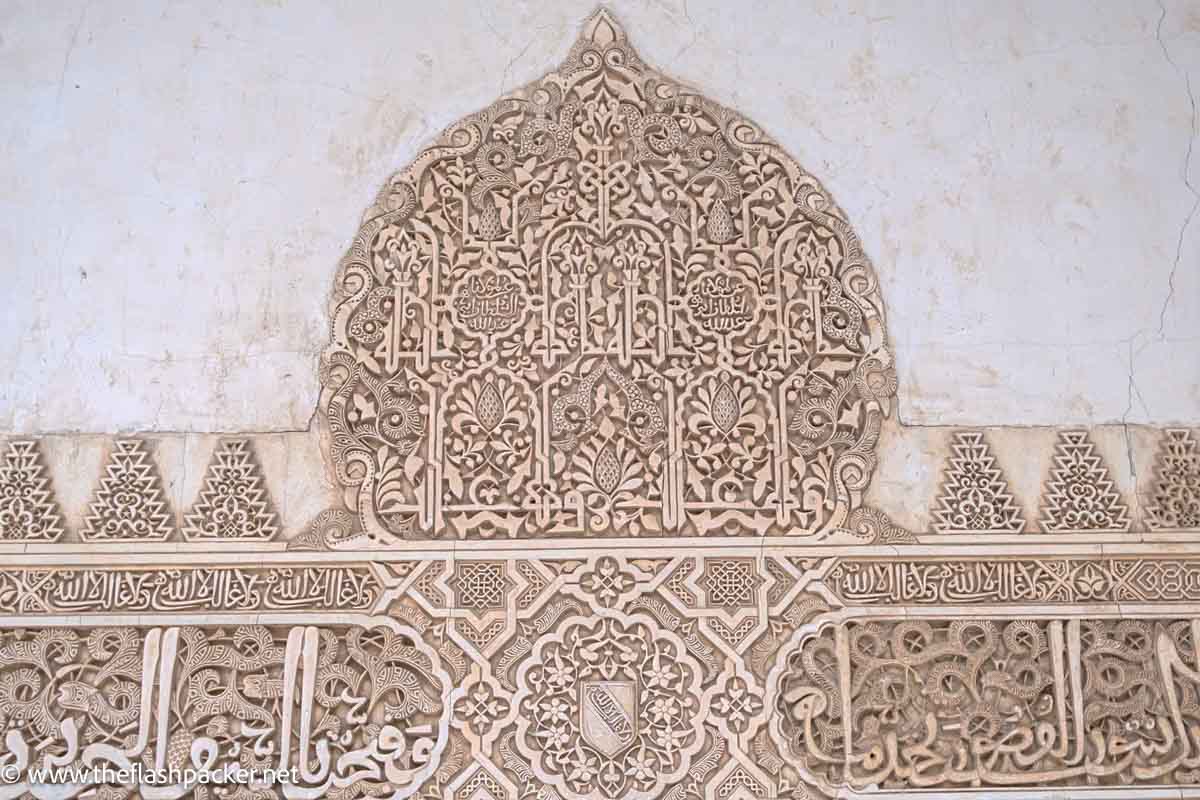
5. Tips for buying Alhambra tickets
Buying Alhambra tickets in advance
The best and cheapest way to buy tickets in advance for the Alhambra is through the palace’s official website. There is also a telephone sales line (858 889 002).
All tickets are non-refundable and you can’t change the date or time of your visit.
There are three types of Alhambra day tickets.
- General Alhambra – this is the most popular ticket and includes admission to the Nasrid Palaces, Generalife Gardens and the Alcazaba.
- Gardens, Generalife and Alcazaba – this grants admission to the Generalife and the Alcazaba but not the Nasrid Palaces.
- Dobla de Oro General – includes all of the above plus entry to the monuments of the Albaaicin
Tickets for night visits are also available. More about this later.
Once you’ve entered your personal information and paid for your ticket, print your ticket or store your confirmation email safely on your phone. You will need to show the QR code on the ticket to gain entry to the Alhambra.
Another option is to buy your Alhambra ticket through a 3rd party reseller.
Think of this as your Plan B if no tickets are available through the official website. Unsurprisingly, these 3rd party tickets attract a booking fee but they are a useful option if tickets for the day of your visit appear to be sold out.
Buying Alhambra tickets on the day
If you want to push your luck, you can try to purchase tickets on the day from the ticket vending machines at the Alhambra’s ticket office pavilion.
What to do if Alhambra tickets are sold out
Don’t panic. You do have a few other options.
Around 30% of advance ticket sales are allocated to travel agencies and some of this allocation is bundled with a guided tour. This can be an excellent way of visiting the Alhambra. Not only does it get you inside the palace gates, but you also benefit from the expert knowledge of a guide.
>>> CLICK HERE TO BUY YOUR GUIDED TOUR OF THE ALHAMBRA
The Granada Card is a tourist pass that includes entrance to the Alhambra, other attractions in Granada and trips on urban buses. When you purchase your Granada Card you will need to choose the date of your visit to the Alhambra.
You can find more information and buy your Granada Card here. Note that the 24-hour Granada Card only gets you into the Nasrid Palaces at night.
Another option is to buy an Alhambra night tour ticket to visit either or both of the Nasrid Palaces and the Generalife and Gardens. But is it worth visiting the Alhambra at night?
In the interests of research, I did a Nasrid Palaces night tour, which was fine but far from ideal. I’m not able to comment on the Generalife at night.
It was busy and because of the volume of people and low lighting, it was difficult to take decent photos. Flash photography and tripods/monopods are not permitted.
If this is your only way of visiting the Nasrid Palaces and/or the Generalife go for it. But manage your expectations.
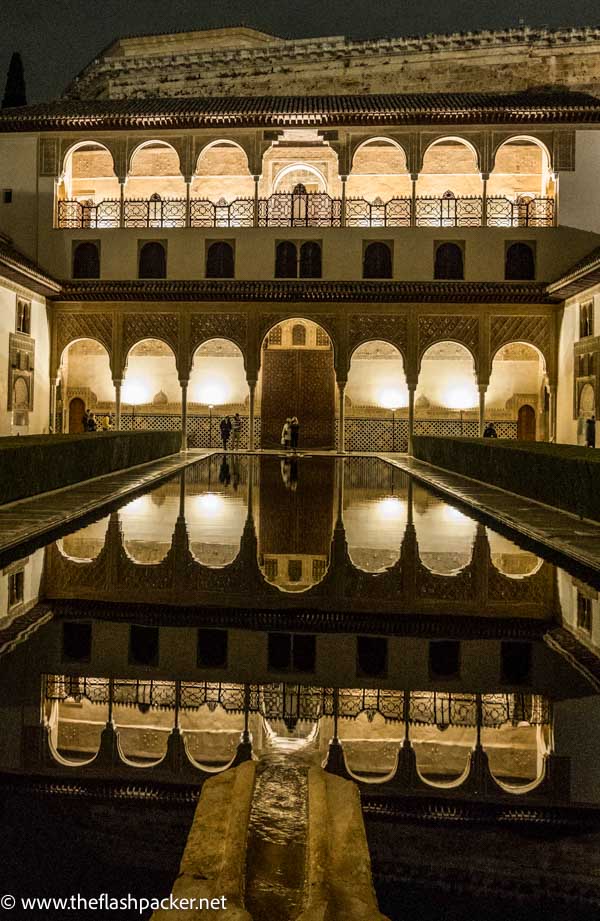
You don’t need a ticket to enter to visit some parts of the Alhambra complex. These areas of the Alhambra are free to visit:
- The Alhambra Museum
- Charles V Palace
- Torre de las Cabezas
- Carmen de los Martires
- Puerta de la Justicia
But I think I would feel very cheated if I visited the Alhambra and didn’t set foot inside the Nasrid Palaces or explore the gardens of the Generalife.
5. Buy your Alhambra ticket for the first time slot of the day
This is well worth setting your alarm clock for. Here’s how it works.
You will need to show your ticket three different times during your visit: at the Nasrid Palaces, the Generalife and the Alcazaba. Whilst you can visit the Generalife and the Alcazaba at any point during your visit to the Alhambra, you can only visit the Nasrid Palaces at the time indicated on your ticket.
I recommend that you visit the Nasrid Palaces first for two reasons.
By arriving before the masses descend – especially the tour groups – you can appreciate the beauty and serenity of these palaces. It will also give you a better chance of capturing beautiful images that don’t include hordes of people randomly aiming their phone cameras in the air.
Secondly, visiting the Nasrid Palaces first means you won’t be clock-watching for the remainder of your visit.
The other logical option is to visit the Generalife first. However, you will need to be careful you don’t miss your time slot for the Nasrid Palaces.
6. Arrive at the Nasrid Palaces before your allocated time slot
You will only be admitted to the Nasrid Palaces at the time indicated on your ticket. If you are late that’s tough luck.
The queues at the Alhambra can be epic, particularly in the peak season. To be on the safe side, arrive at the entrance to the Nasrid Palaces around 20 minutes before the time indicated on your ticket.
If the queue appears long when you arrive don’t panic. It moves pretty quickly.
7. Don’t forget your passport
You need to provide your passport details when you purchase your Alhambra ticket. No passport, no admission. That’s the rule.
Furthermore, this needs to be the original document, not a copy or a photo.
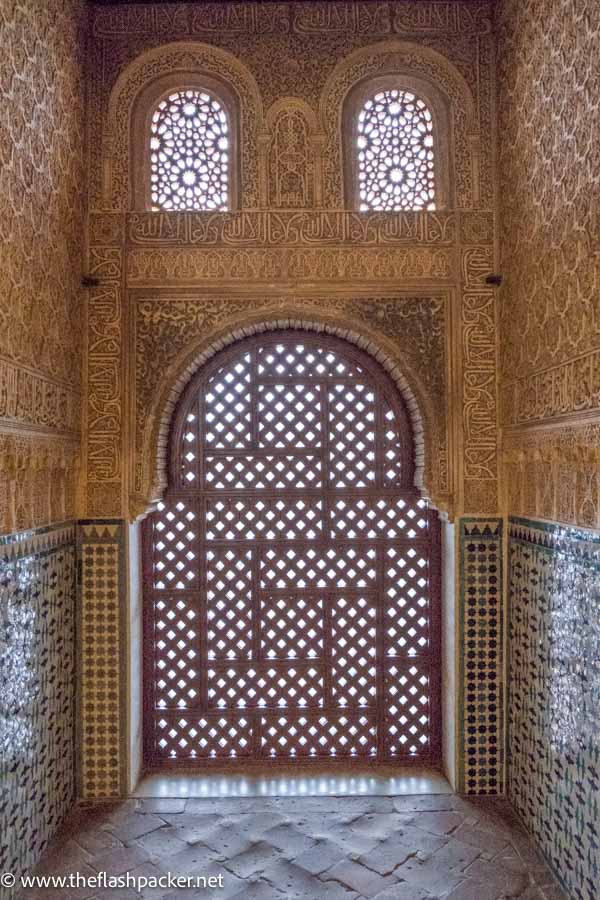
8. Plan how to get to the Alhambra
If you are starting your visit to the Alhambra at the Nasrid Palaces, enter through the Gate of Justice (Puerta de la Justicia). To get to the Generalife, head further up the hill towards the main entrance.
There are three main ways to get to the Alhambra Palace from the centre of Granada: on foot, by bus or by car/taxi.
Although it is a steep uphill climb, it is a scenic walk to the Alhambra. You have a few options.
Starting in Plaza Nueva, climb the Cuesta de Gomérez to reach the Gate of the Pomegranates, a Renaissance gateway built by Carlos V. From here, the entrance to the Nasrid Palaces is a short distance along a path to your left.
Alternatively, from the Palacio de los Tristes cross the river and take the Cuesta de Rey Chico that winds its way along the side of the palace complex. This brings you to the main entrance, from where it is a 10-minute walk to the Gate of Justice.
There is also a third path, Cuesta del Realejo, from Plaza del Realejo.
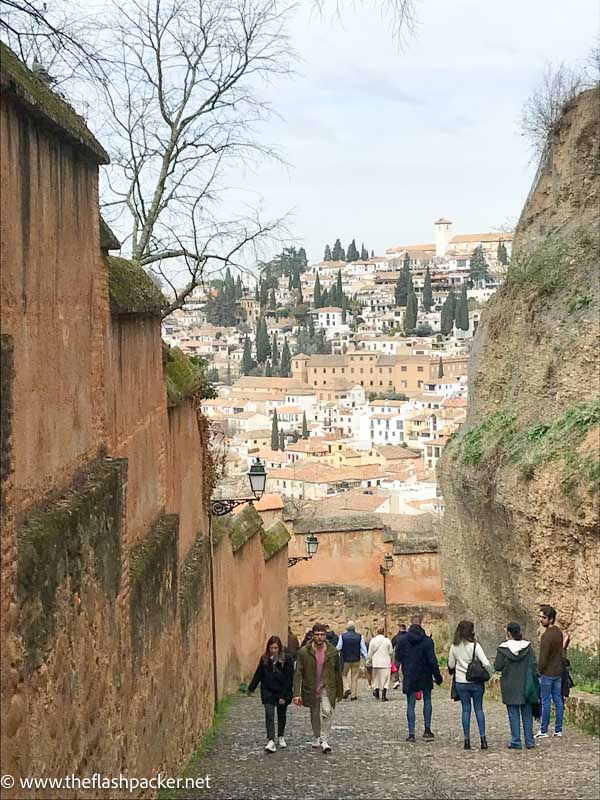
If you want to save yourself an uphill climb, catch the minibus from Plaza Nueva. Minibuses number 30 and 32 start running shortly after 7 am with the last service returning at 11 pm.
9. Allow enough time for your visit
Don’t rush your visit to La Alhambra. This is something to savour, not just ticked off a travel bucket list.
But how much time should you spend at the Alhambra?
Ideally, you should spend the better part of a day there. At a minimum, I recommend allowing at least 3 – 4 hours for your visit. You need to allow time to walk between the sights and for queueing.
I spent four hours there on my second visit (3rd if you count the night visit to the Nasrid Palaces).
As a guide, I suggest breaking down your visit to the main sights like this:
- Nasrid Palaces: 90 minutes
- Alcazaba: 20 – 30 minutes
- Generalife: 30 minutes
- Charles V Palace: 10 – 15 minutes
10. Have a good breakfast before you set out
As food and drink options inside the Alhambra are limited, have a good breakfast before your visit. You’ll need the sustenance.
11. Make a beeline for the Patio de los Arrayanes and the Patio de los Leones
These patios are two of the Alhambra’s most popular and most photographed areas for very good reasons.
The Patio de los Arrayanes (Court of the Myrtles) is at the centre of the staterooms of the Nasrid Palaces. This exquisite courtyard features a serene pool and fountain, flanked by myrtle hedges and has elegant marble colonnades at each end.
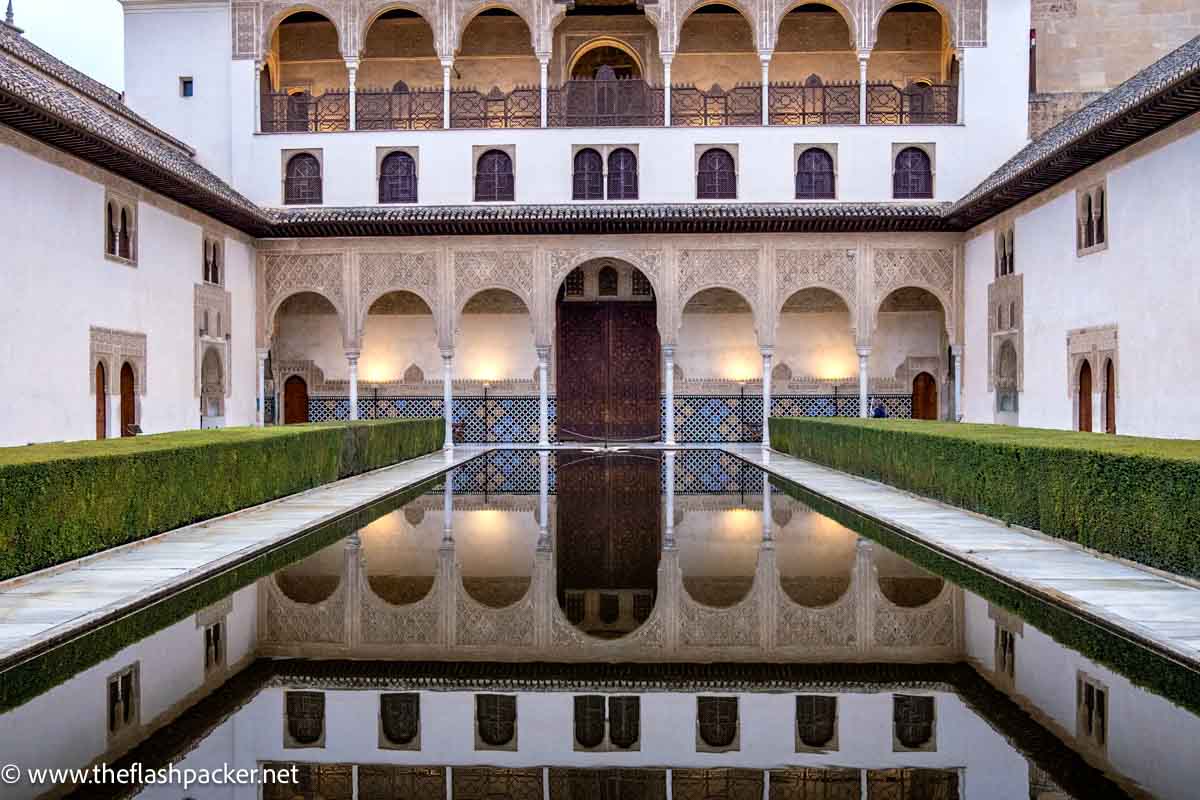
Patio de los Leones (Court of the Lions) is at the heart of the harem, in the third section of the Nasrid Palaces. This patio with its central fountain featuring 12 lions is an enduring image of the Alhambra.
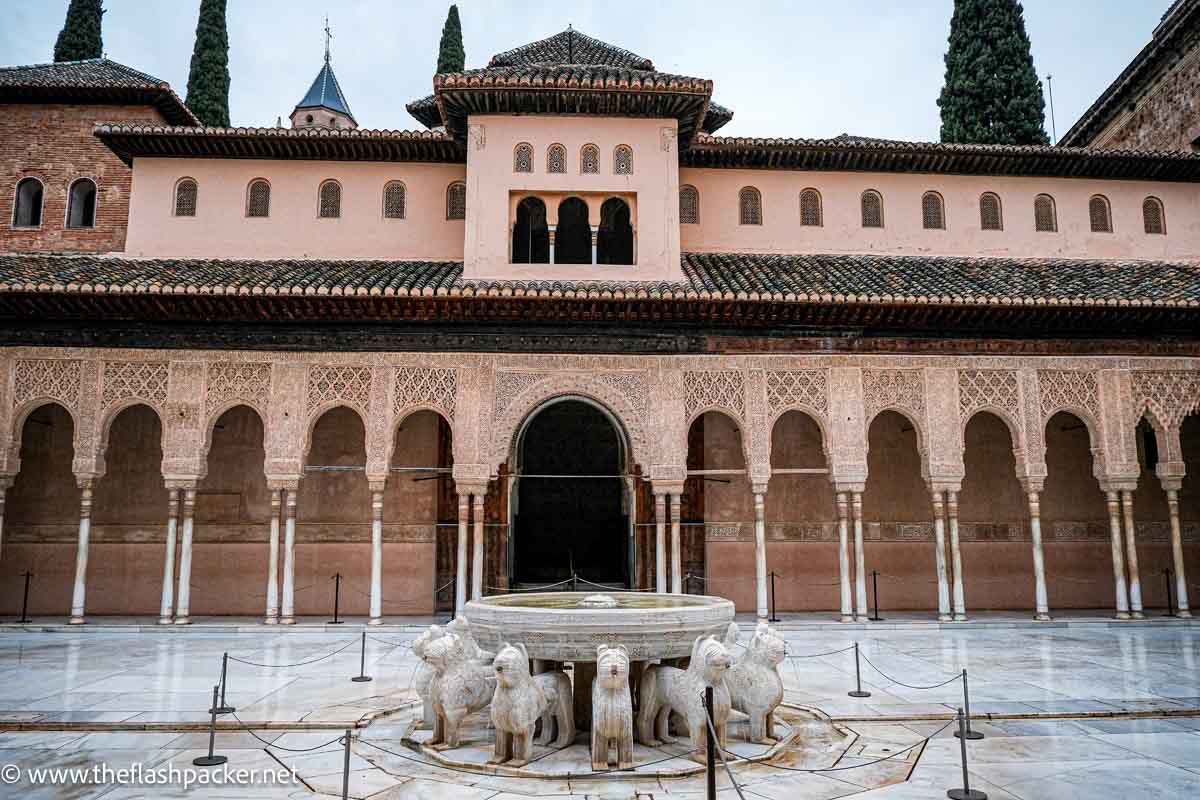
Make your way towards these patios as soon as you enter the Nasrid Palaces. You will be able to enjoy the serenity of these beautiful spaces and should also be able to capture relatively people-free images of them.
Except for a few cleaners and a friendly security guard, I had the Patio de los Arrayanes and the Patio de los Leones to myself for the first 10 -15 minutes of my visit. Once visitor numbers started building, I backtracked to the rooms closer to the entrance of the Nasrid Palaces.
12. Don’t miss these other Alhambra highlights
Of course, the Patio de los Arrayanes and the Patio de los Leones aren’t the only things to see at the Alhambra. Here are a few more attractions to look forward to.
GENERALIFE
Above all, don’t skip the Generalife (Palacio de Generalife). This was the summer palace of the Nasrid kings. From its terraces, there are fabulous views of Granada.
The Generalife’s main draw is its gardens which include the Patio de la Acequia (Water-Garden Courtyard) and the Jardín de la Sultana (Sultana’s Garden).
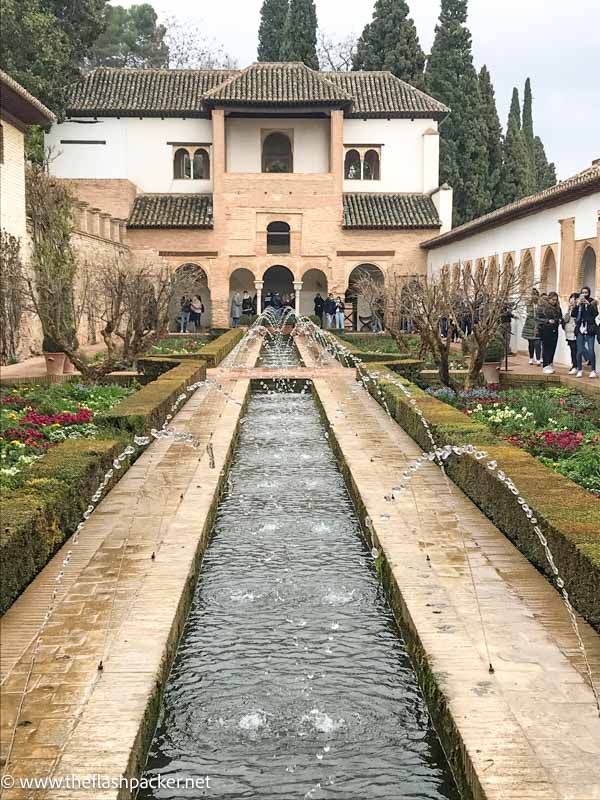
SALA DE LOS REYES

At the far end of the Patio de los Leones, the alcoves of the Sala de los Reyes preserve a series of vivid paintings of Nasrid kings. These are thought to have been painted by a Christian artist in the last decade of Moorish rule
SALA DE LOS ABENCERRAJES
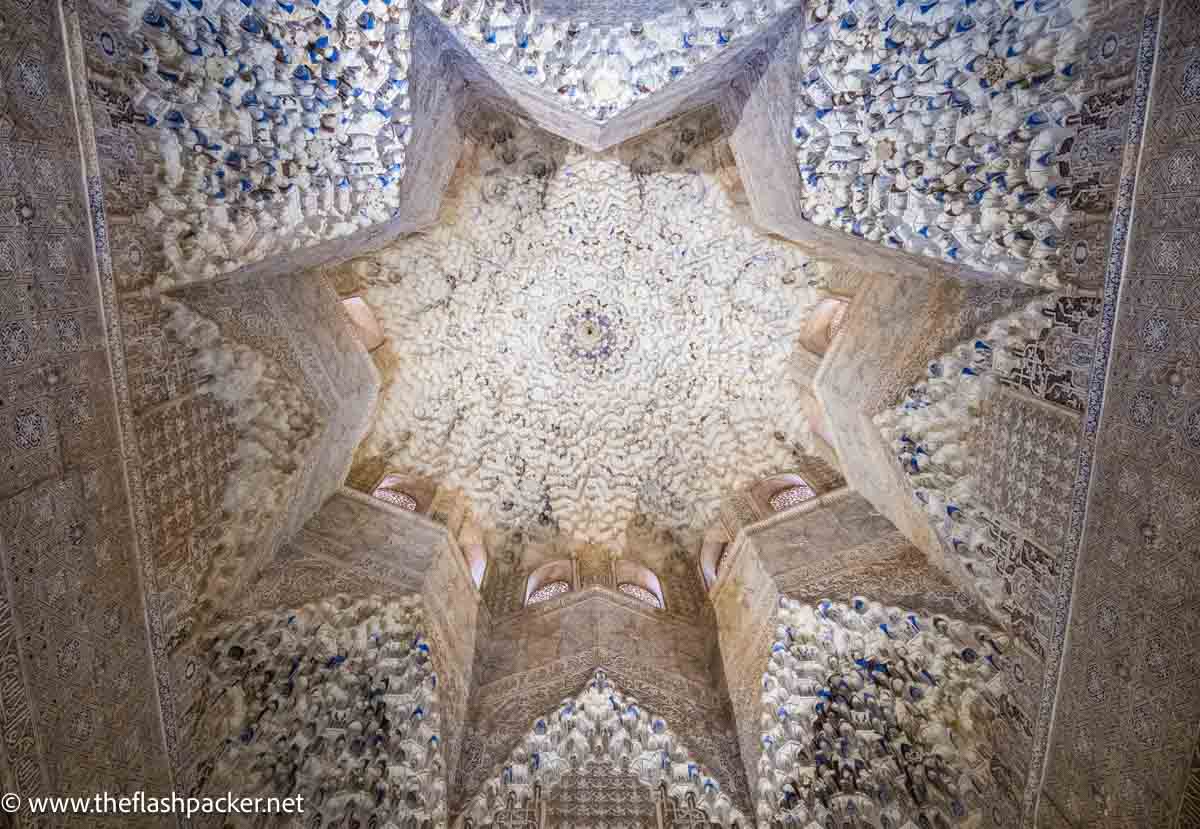
The Hall of the Moors is the Alhambra’s most beautiful gallery. It features an ornate ceiling with a star-shaped cupola and astonishing stalactite vaulting.
SALA DE LAS DOS HERMANOS
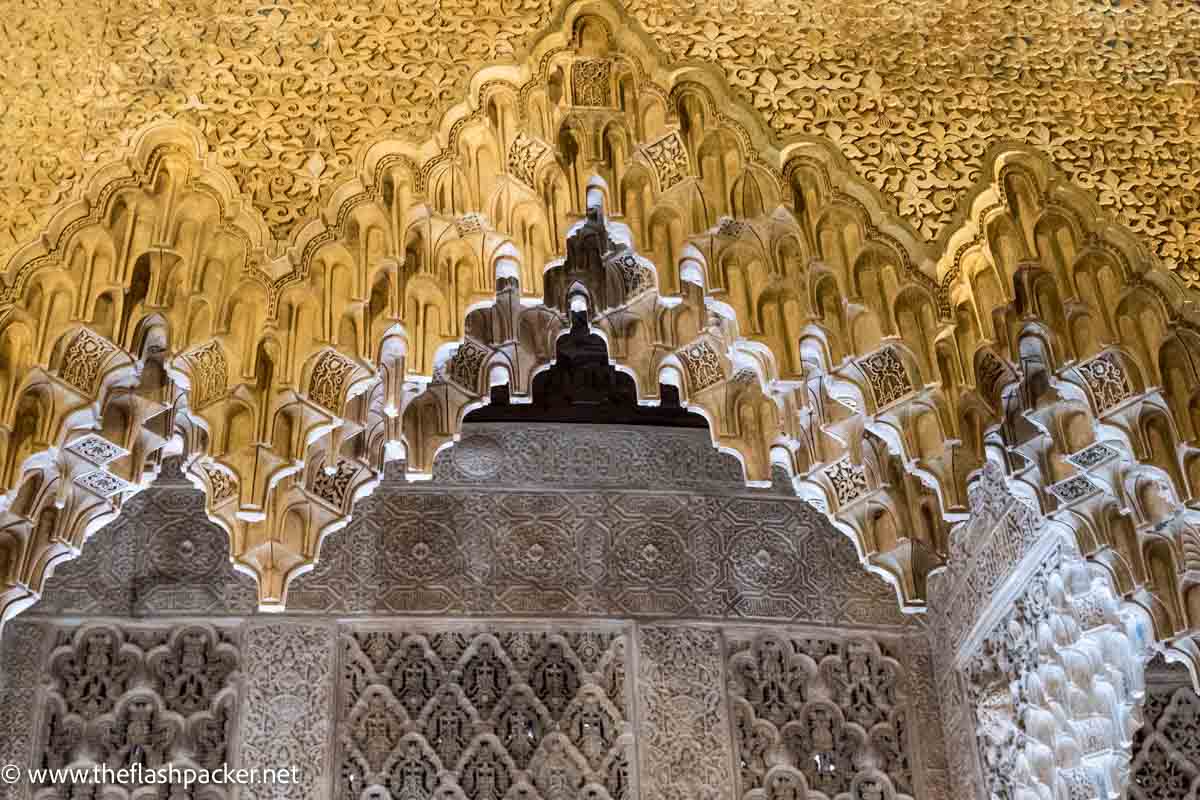
In the same complex as the Sala de los Abencerrajes, the Hall of the Two Sisters features a spectacular ceiling dome of over 5000 honeycomb cells.
GARDEN OF DARAXA
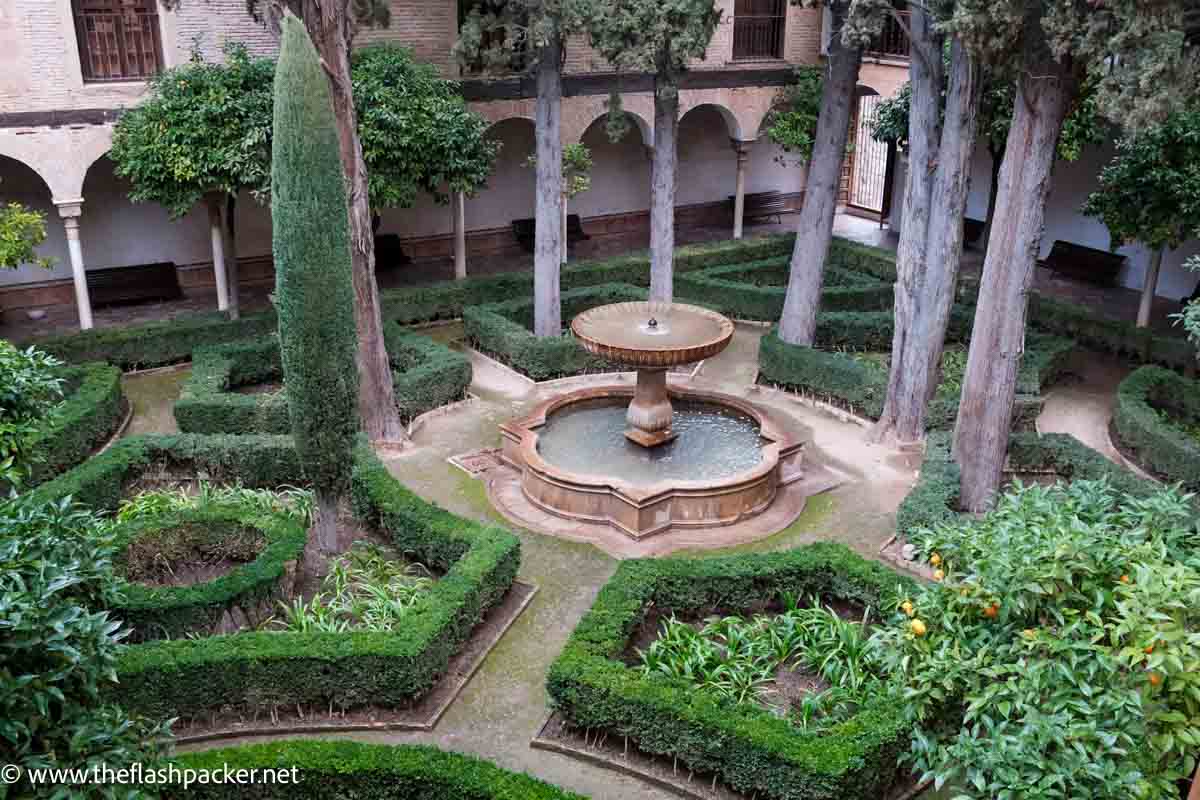
Also called Garden of the Orange Trees (Jardín de los Naranjos) and Garden of the Marbles (Jardín de los Mármoles), Daraxa’s Garden was built between 1526 and 1538.
ALCAZABA
The Alcazaba is the oldest, but most ruined, part of the Alhambra. Walk to the Torre de la Vela at the Alcazaba’s summit for spectacular views of Granada and beyond.
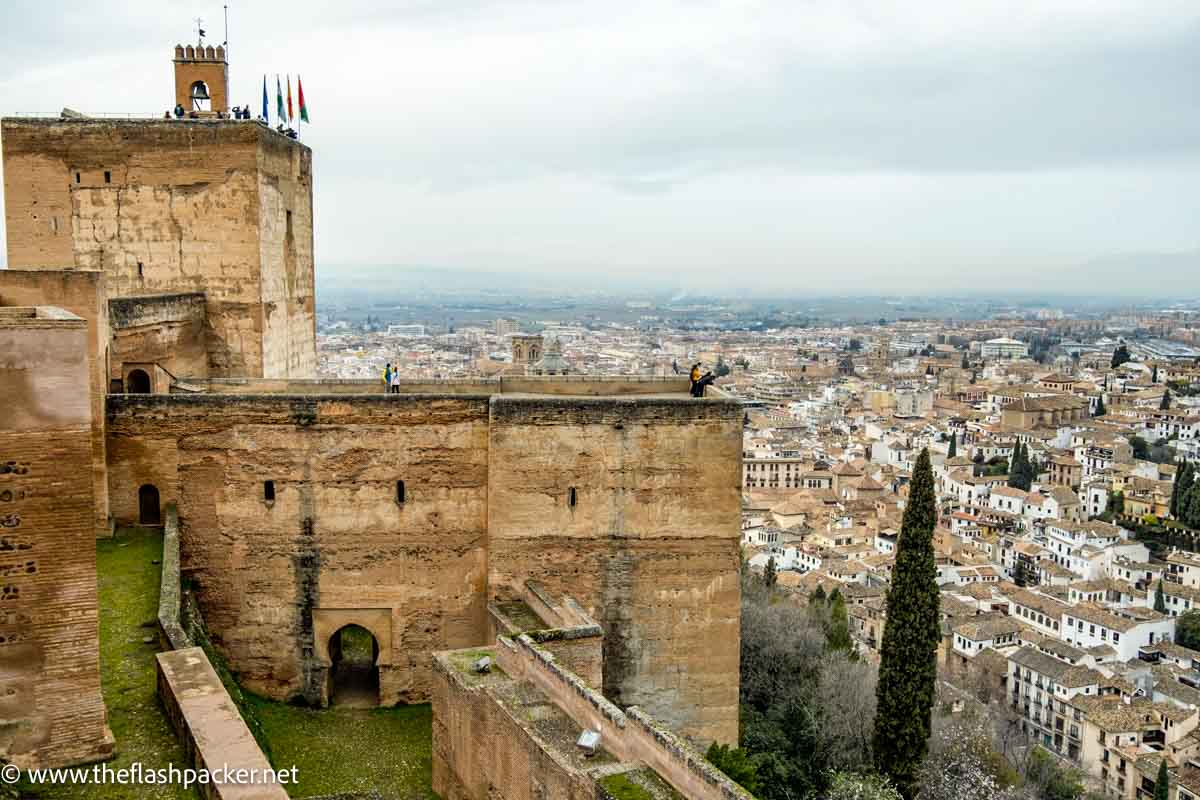
CHARLES V PALACE
Facing the Alcazaba is the splendid Renaissance Palace of Carlos V, looking oddly out of place.
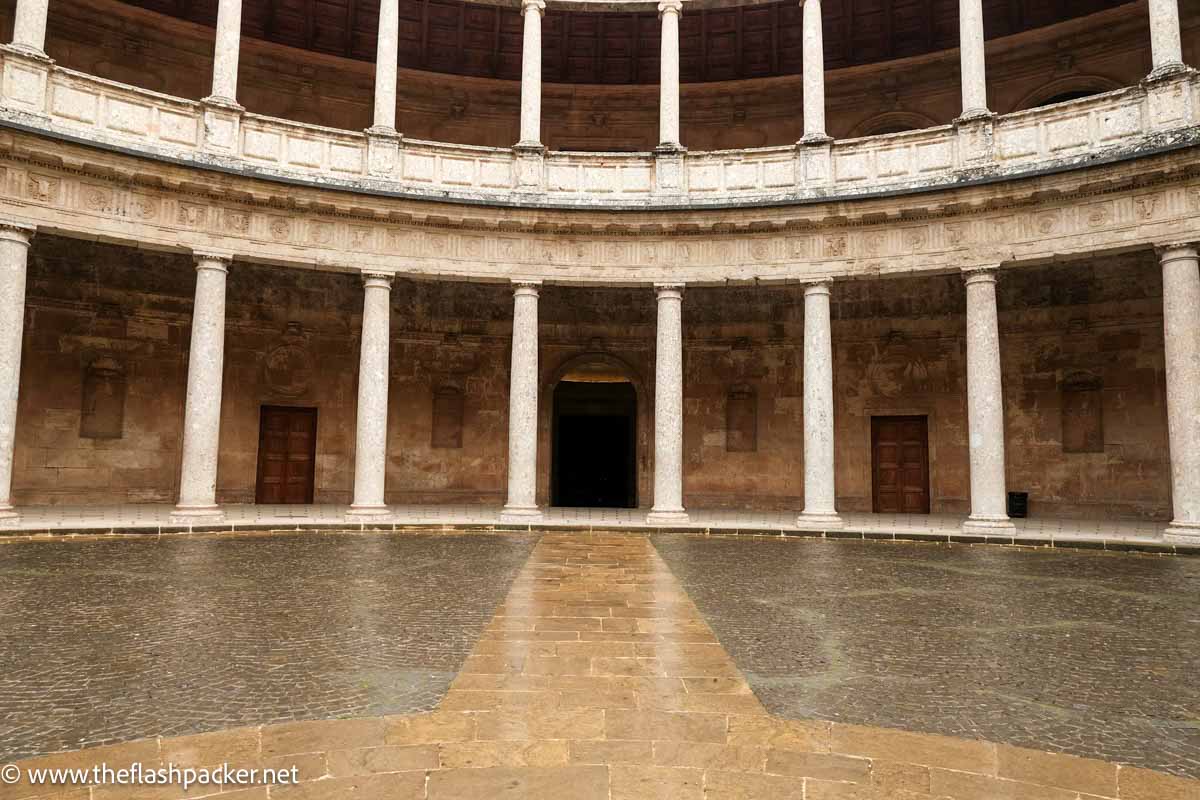
BAÑO DE LA MEZQUITA
These wonderful mosque baths were built following the model of Roman thermal baths.
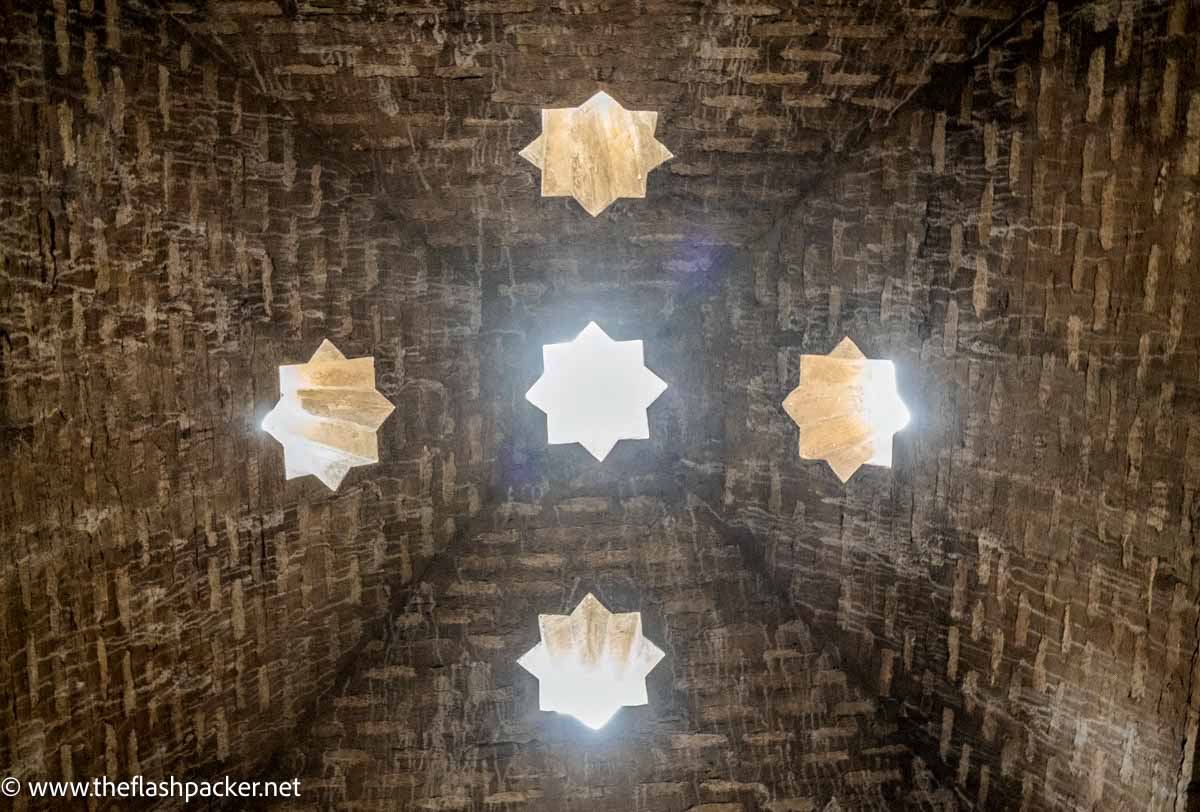
EL PARTAL
Derived from an Arabic word meaning “the portico”, El Partal was the residence of Sultan Yusuf III and is the northernmost of the Nasrid Palaces. All that remains are the archaeological excavations of some of these homes amongst the terraced gardens planted in the 20th century.
13. Download the Alhambra app or rent an audio guide
This is one place where you will benefit from a guide. Although there are no live guides on-site, you can rent an interactive Alhambra audio guide.
This is available in 12 languages from the entrance pavilion or at the Palace of Carlos V. Featuring a choice of routes, it includes an interactive map of the complex, historical images and videos.
Alternatively, you can download the guide to your mobile phone.
14. Try to squeeze in a visit to the Alhambra Museum
This little gem doesn’t attract much attention but is wonderful at providing contextual information about what you are seeing at the Alhambra Palace. There’s everything you need to know about Islamic decoration and more.
You’ll find the Alhambra Museum next to the Charles V Palace. Photography is not allowed inside.
15. Explore other sights in Granada for context
Although the Alhambra pulls in the crowds, Granada has more to offer than this palace complex, as monumental as it may be. Visiting some of the city’s other attractions will help you place what you see at the Alhambra in the context of the city below.
Become better acquainted with Granada’s Moorish past by strolling the narrow streets of the Albaicín neighbourhood, perched on the hillside opposite the palace complex. From here, there are classic views of the Alhambra, particularly from Mirador de San Nicolás.
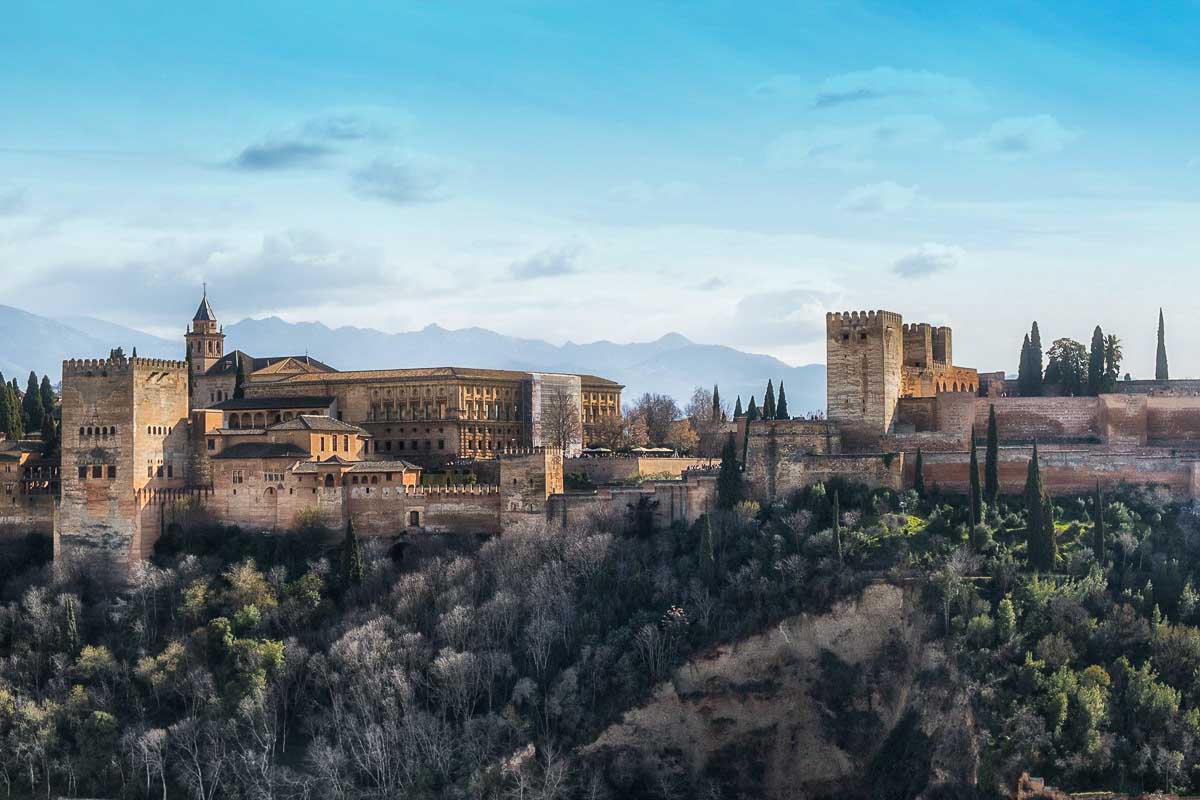
Visiting the Alhambra: Useful Information
Ticket price
In December 2024, a general admission ticket for the Alhambra costs €19.09. If you want to visit the Generalife and gardens only, this costs €10.61.
A night visit to the Nasrid Palaces costs €10.61 (gardens and Generalife €7.42).
Backpacks and luggage
Access with backpacks or bags larger than 40×40 cm is not allowed. Subject to capacity, there is a free left-luggage service at the main ticket pavilion.
Photography at the Alhmabra
Photography without a flash is allowed throughout the palace complex. Tripods and monopods are not permitted.
Selfie sticks are not allowed in the Nasrid Palaces or any other enclosed space.
Where to Stay in Granada
I stayed at Casa Morisca, a wonderful hotel close to the start of the Cuesta de Rey Chico. From my tiny balcony, there were views of the Alhambra. It was a splurge but totally worth it.
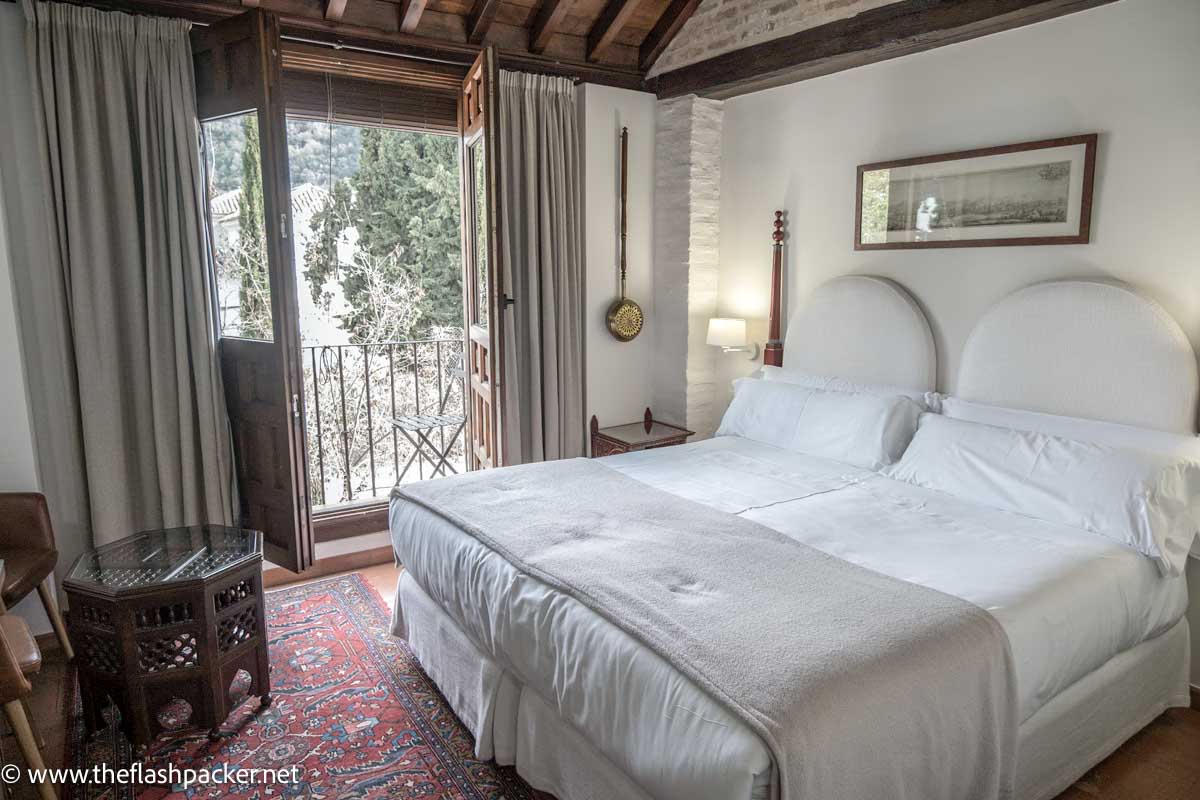
>>> CLICK HERE TO FIND OUT MORE
Here are a few other accommodation options that I have found that may suit other tastes or budgets:
Mid-range hotel – Aurea Catedral by Eurostars
Close to Granada Cathedral, this 4-star hotel offers modern, comfortable rooms in a central location.
>>> CLICK HERE TO FIND OUT MORE
Budget hotel – Room Mate Leo
This 3-star hotel offers modern rooms in a traditional building close to the cathedral.
>>> CLICK HERE TO FIND OUT MORE
Which is Better? Granada’s Alhambra Palace or the Real Alcázar of Seville?
It’s only natural to compare the Alhambra with the Real Alcázar of Seville. Both of these UNESCO-listed sites are renowned for their architectural beauty and many of the workmen were responsible for both palaces.
There’s not a lot in it but in my view, the Alhambra just about trumps the Real Alcázar.
Ideally, you need to set aside the better part of a day to visit the Alhambra. This palace complex is larger and more spread out than the Real Alcázar of Seville. Half a day should be an ample length of time to spend at the Real Alcázar of Seville.
It’s easy to get to Seville’s Royal Alcázar as it is located in the heart of the city. The Alhambra is perched on a hill overlooking Granada’s city centre and getting to it involves a steep uphill walk or a bus journey.
That said, for me, the Alhambra, and especially its Nasrid Palaces, is the most spectacular of the two palaces. I also love the sheer romance of the Alhambra.
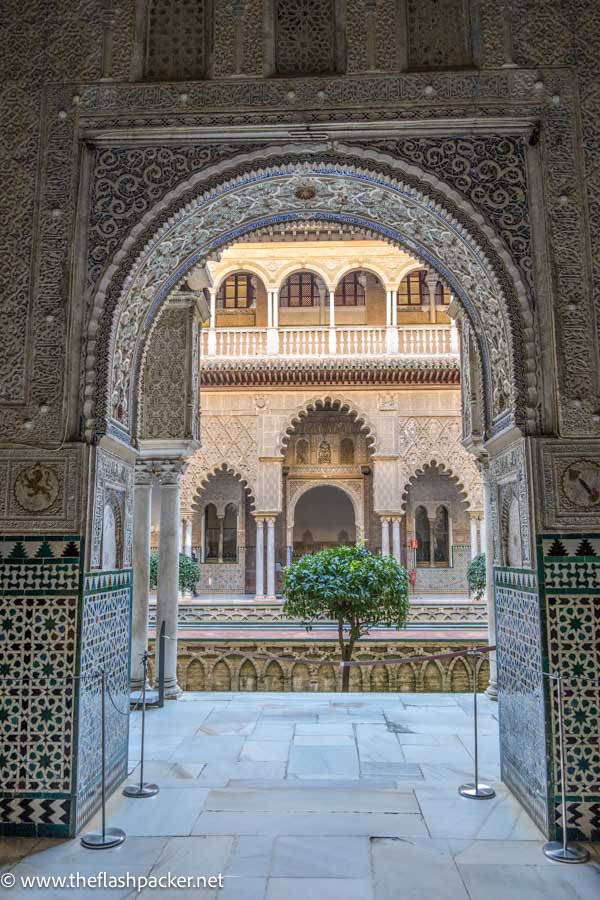
Thank you for reading my guide to the best way to visit the Alhambra
I hope that these tips help you have a wonderful visit. If you have enjoyed this article, why not get the lowdown on other things to do in Granada?
Planning an Andalusia itinerary? If so, discover how to spend three days in Seville. This includes its top two attractions: Seville Cathedral and tips for visiting the Real Alcázar of Seville.
I also have an in-depth Cordoba 1-day itinerary (one of my favourite Spanish cities).
For broader travel in Spain, take a peek at some more of my guides:
- 2 Days in Barcelona: Itinerary & Best Things to Do
- One Day in Barcelona from a Cruise Ship: Itinerary & Best Things to Do
- Top 10 Things to Do in Tarragona: Spain’s Roman City by the Sea
- 15 Fabulous Reasons for Visiting Valencia, Spain
- Solo Travel in Portugal and Spain: 10 Unmissable Places to Visit
Happy travels!
PS. If you’ve found this guide helpful, Pin it to read later!

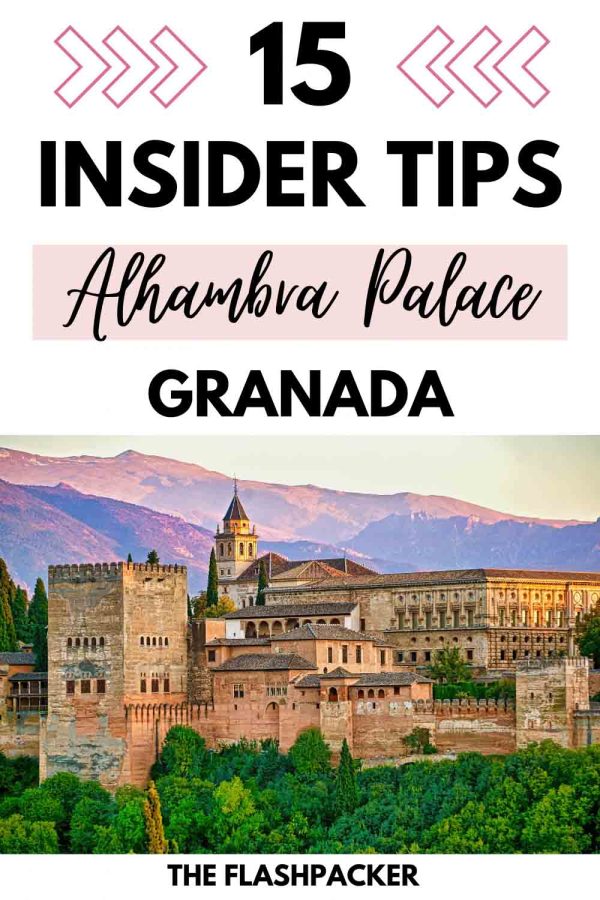

About Bridget
Bridget Coleman has been a passionate traveller for more than 30 years. She has visited 70+ countries, most as a solo traveller.
Articles on this site reflect her first-hand experiences.
To get in touch, email her at hello@theflashpacker.net or follow her on social media.
